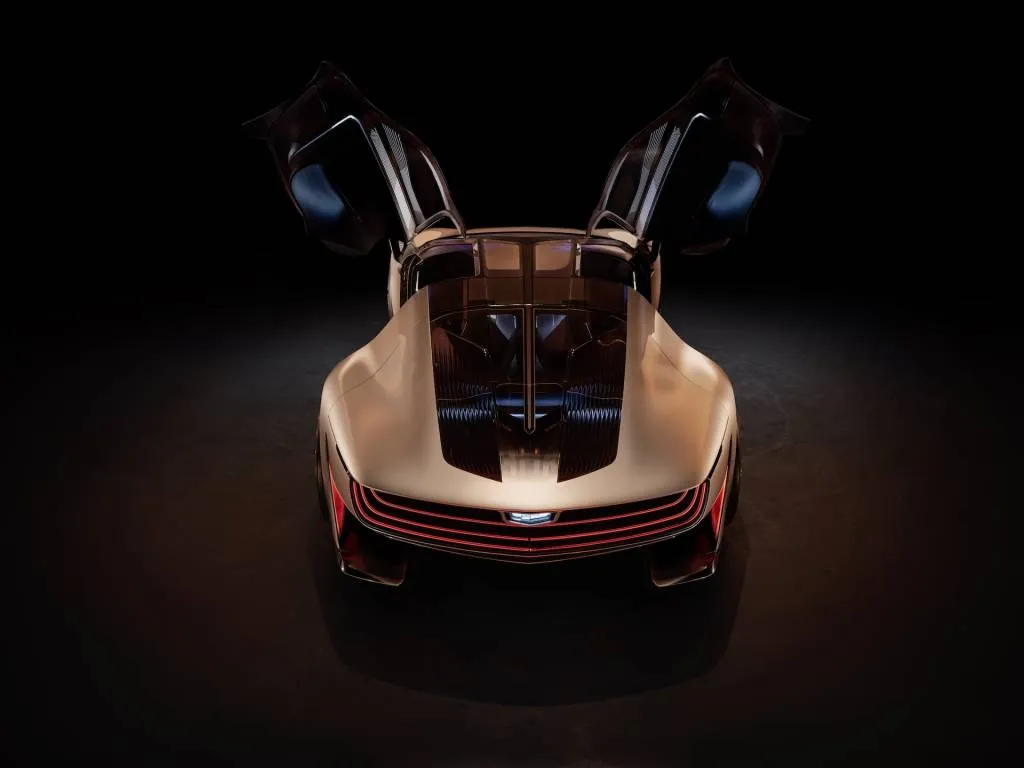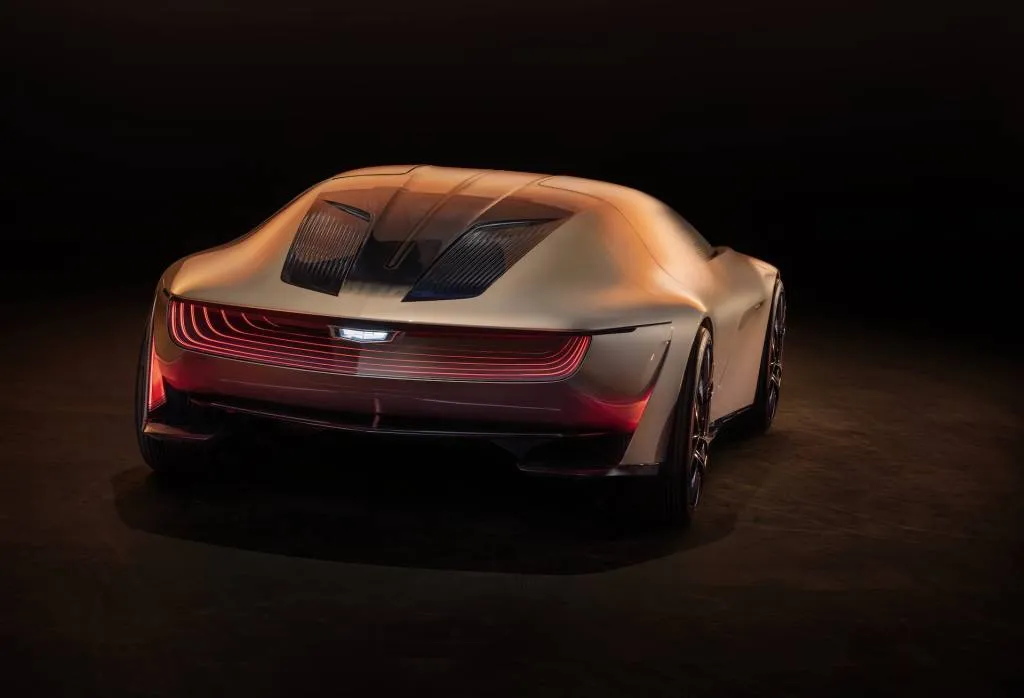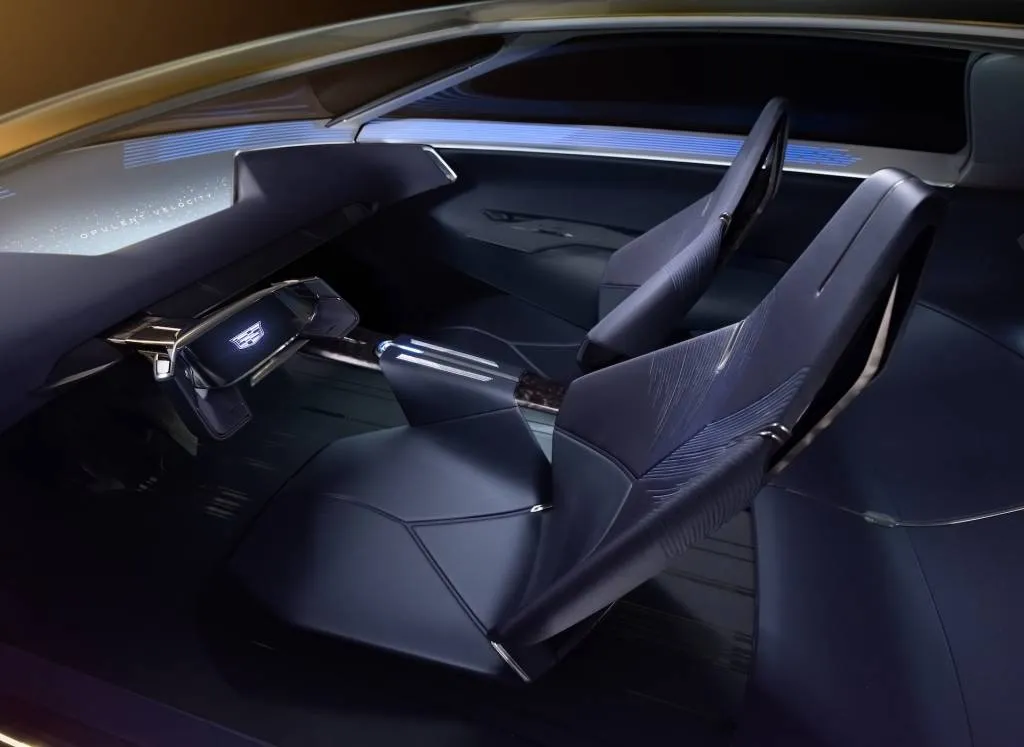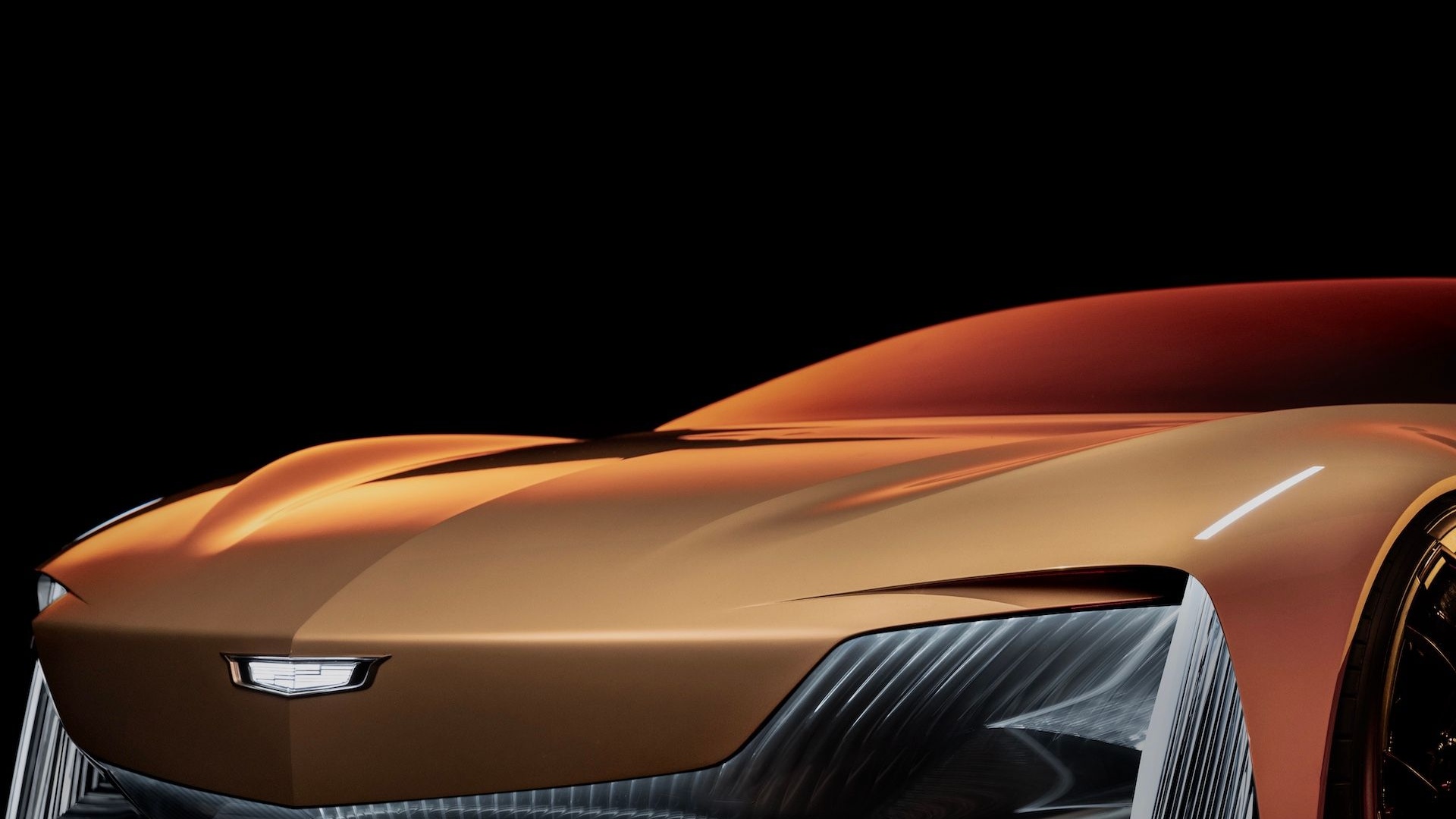- Cadillac's latest ultra-luxury EV concept bows this week in Monterey
- No specifics published on its EV powertrain
- It joins the Celestiq and Sollei in Cadillac's portfolio of super-expensive EVs
- Will a Blackwing join this mooted V-Series?
The Cadillac Opulent Velocity concept, unveiled Friday at The Quail during Monterey Car Week, shows where GM’s global luxury brand could take its V-Series performance line as it transitions to battery-electric vehicles.
First teased back in March, the Opulent Velocity is a 2+2 coupe whose most striking feature is likely the powered butterfly doors. Cadillac has leaned into a heavily sculptured form with a side graphic that drops sharply; execs said that makes the rear wheels more prominent to convey a “power message” without having to be “brutal.” Those wheels have lighted spokes, a novel touch inspired by Formula 1 that will also draw attention to the car.
Inside, it’s a traditional 2+2 performance coupe, with an interior that “cocoons, encapsulates, and hugs” the driver and passengers. Not only does it sport a future generation of infotainment and projection displays, but the car includes biosensors to adjust its interior environment to soothe or entertain occupants. While the exterior appears as if it could be built today, lights and mirrors aside, the interior is clearly more conceptual.
Cadillac reaches for the ultra-luxury atmosphere
The concept coupe is related both to the 2025 Cadillac Celestiq limited-production sedan (yes, the $340,000 one) and the Sollei EV concept unveiled in July. These vehicles are likely targeted as much at China, the brand’s largest market for most of a decade, as they are at North America.
GM’s Ultium battery architecture underpins all of its new EVs, from the Celestiq down to a coming update of the humble Chevrolet Bolt EV. But the Celestiq platform could spawn numerous high-end, very luxurious models. The intent is to “elevate the brand” and “foreshadow” future vehicles, said executive global design director Bryan Nesbitt during a media briefing before the launch.
So while Celestiq is the first ultra-luxury Cadillac in many decades, it’s likely not the last—just as the Sollei EV concept demonstrated.

Cadillac Opulent Velocity Concept
Luxury performance: more than 0-60 mph
Cadillac execs talked at length about the concept’s dual personality, the “two dynamic extremes” reflected in its name. They reflect the “artful integration of technology, luxury, and exhilaration” in both driving modes they envision.
Opulent is the one for normal, day-to-day travel, in which the car pampers both driver and passengers. That means an “immersive experience” in hands-free driving, with augmented reality on a future generation of head-up displays and both sound and light creating an ambience of relaxation. The goal is to ease driving effort in traffic, help drivers find specific locations, and other useful information that won't distract drivers.
Cadillac said its “autonomous drive” technology would be a Level 4 system that would allow drivers to look away from the road provided they are driving in a specified area, but they would have to take control when prompted. Those prompts could be easy to spot because the yoke-style steering wheel and pedals would retract during autonomous driving and present themselves when needed.
Then there’s the Velocity mode, for sheer performance and even track use, of the kind offered by the Tesla Model S Plaid, the Lucid Air Sapphire, the future Polestar 5, and other pricey EV performance sedans. Brandon Vivian, Cadillac’s executive chief engineer, said the brand even “aspires” to compete with the likes of Ferrari, Lamborghini, and Rimac. (Cadillac hypercar, anyone?)

Cadillac Opulent Velocity Concept
The V-Series lives on in EVs
The V-Series and Blackwing performance variants have given the former luxury-only brand a distinct boost, its execs said. Its buyers are younger, they buy multiple V-Series models, and fully 80% of them are conquests from other brands—not something that could be said two decades ago in the days of the old Sedan de Ville.
Cadillac’s new racing efforts—its return to Le Mans, for example—play into the high-performance image of the brand. Strong performance that has equaled and occasionally led a segment, racier appearances backed up by proper handling, and snarling exhausts have defined the V-Series for the gasoline age.
The problem is that, even if Cadillac has backed off its all-EVs-by-2030 pledge, its largest market will increasingly demand EVs in all segments. For most of the past 10 years, China has been the brand’s highest-volume market. In July, more than half the new vehicles sold there had plugs, and that trend will not reverse.
With homegrown Chinese brands now offering fully competitive cars, sales of mass-market U.S. brands in the country are plummeting. So Cadillac will move significantly upmarket there, as GM CEO Mary Barra has said multiple times of late. The Celestiq is the opening shot in that salvo, and there will be more.

Cadillac Opulent Velocity Concept
A Blackwing in the wings, too?
Meanwhile, the brand will clearly hang onto the V-Series to burnish Cadillac’s new performance credentials. But what is performance in EVs?
“Deltas in 0-60 times are not a differentiator” anymore in luxury EVs, said Vivian. Instead, the brand feels it must surpass rivals in “the whole vehicle experience,” including “when it’s driving itself as well,” to make its highest-end EVs stand apart from the crowd.
Responding to a reporter’s question, Vivian said Cadillac was studying “how best to deliver the performance aspects” of V-Series in a “version of Ultium yet to come in the future.” He hinted at the possibility of a dedicated Blackwing entry in its EV lineup as well.
Ah, but are its younger, more performance-minded V-Series buyers ready to go EV? Vivian seemed unfazed. He responded, “Authenticity is really critical to the V-Series customers, and the performance (offered) will be tremendous, outstanding.” Those customers “look forward to full electric vehicles,” he said, and what they can offer with both the power of future onboard computing and the energy to deliver that performance.
Otherwise, we know virtually nothing about the powertrain or mechanicals of the Opulent Velocity concept. Press materials did not contain the words “battery” or “power” or “kilowatts” or “horsepower.” Instead, they focused on the car as a pointer to a new generation of Cadillac: a “pure expression of the future” showing how “Cadillac’s revered sense of opulence” can evolve while “envisioning a zero-emission expression of performance and modern luxury.”
More is yet to come, clearly. Watch for future Cadillac EV concepts that move the brand well upmarket from the Lyriq midsize SUV, which in July was, Vivian said, the second best-selling luxury EV in the U.S. Because GM no longer releases monthly sales, we’ll have to wait until October to learn just how well Cadillac’s sole EV currently on sale is doing, V-Series or not.






